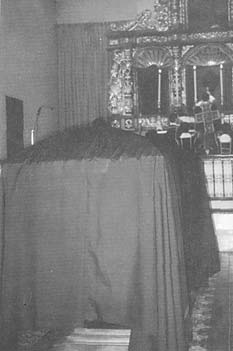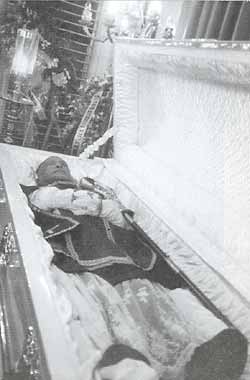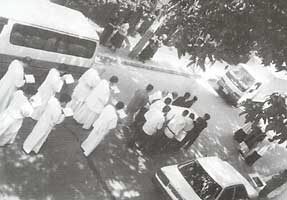The Warrior's Autobiography
 |
The Archdiocese of Tuguegarao is my home diocese. As a diocese it was carved from the Diocese of Nueva Segovia in 1910 and elevated into an Archdiocese in September 1974. The suffragan dioceses, that is, those that are subordinate to a metropolitan or archiepiscopal see, are dioceses of Ilagan and Bayombong, and the prelature of Batanes-Babuyanes.
The provinces comprising these dioceses with their 1998 population counts are Cagayan (pop. 995,572), Isabela (pop. 1,189,739), Batanes-Babuyanes (pop. 23,998), and Nueva Vizcaya (pop. 446,084).
Tuguegarao is the capital town of Cagayan province. Cagayan Valley is irrigated by the Rio Grande River, also called Cagayan River, the longest river in the Philippine archipelago. The southeastern part of Cagayan is known as the Itawis District. The district is divided into three parts by the Rio Chico, a tributary of Rio Grande. On the banks of the Chico River are situated the towns of Tuao, Rizal, Piat, and Sto. Niño where I saw the first light of day on May 1, 1917. [ "Sto." is an abbreviation for "Santo," meaning, "Holy." In this case, "Sto. Niño " means "Holy Infant."—Ed.] Seven children came to bless the union of my parents. I was the third child. My parents, Fortunato and Emiliana Lazo, were financially poor but rich in their love for God and for their fellowmen. My father studied law and served as Justice of the Peace of our little town. Every night my father led the family in reciting the holy rosary and accompanied his family to Sunday Mass. My mother on the other hand, invited the pagan Igorots and Kalingas of the Cordillera Mountains which border Cagayan Province to the west to barter their forest products like rattan and forest root-crops. In exchange, my mother gave them laundry soap, matches, small knives, and second-hand clothes. She regularly laundered the altar linens of the parish church. In summer she invited the Kalingas and Igorots to come to our house so that she could teach them the catechism. My mother passed away while giving birth to her seventh child in 1926. Aunt Lorenza, her sister, took care of us in our growing years. The family roots can be traced to the small town of San Vicente, Ilocos Sur, located along the coast of the China Sea of the Cordilleras. They moved to Cagayan due to political disturbances caused by the Philippine Revolution (1898-1909). ]The Philippine Revolution was a native uprising against Spanish rule.—Ed.]
In 1934, the bishop of the Diocese of Tuguegarao was the Most Rev. Constance Jurgens, C.LC.M., D.D., Dutchman, known for his holiness of life, his apostolic zeal and Christ-like charity to the poor. Having finished my elementary grades in Sto. Niño Central School in 1933, my father brought me to Tuguegarao to study at the Cagayan High School because, in those days, Sto. Niño did not have a Catholic high school nor a Catholic elementary school.
|
|
|
A procession steps off to the provisional mortuary chapel to meet Bishop Lazo lying in state.
VOCATION
An arrangement was made for me to stay in the dormitory of the boys living under the care of the bishop; Fr. Oscar Deltor, C.LC.M., was the prefect of discipline. At the end of the school year Bishop Jurgens told me that he was going to send me to Christ the King Mission Seminary in New Manila, Quezon City. That was in 1935. When I graduated from the classical secondary in Christ the King Mission Seminary, I went on to college. At the end of the academic year in March 1940, the Rector, Very Rev. Herman Konding, S.V.D., informed me about the death of my father. I went home but he was already buried when I reached Sto. Niño.
|
|
|
The middle picture shows His Excellency Bishop Fellay
sprinkling the body with holy water and intoning the antiphon, Si in iniquitates,
which opens the chanting of the De Profundis (Ps. 129).
|
Bishop Lazo's casket will soon be closed and born to Our lady of Victories. |
In 1942 World War II broke out. Being a Dutchman, Bishop Jurgens was rounded up with all the foreigners who were considered enemies of Japan. Japanese Armed Forces sent him to the concentration camp in Los Banos, Laguna. American missionaries in Christ the King Mission Seminary joined their fellow Americans either in the University of Sto. Tomas concentration camp in Manila or in Los Banos.
Christ the King Mission Seminary was built along E. Rodriguez Avenue, a road through one of the suburbs of Manila. The predictions, then, were that a division of the American Liberation Forces under the command of Gen. Douglas MacArthur was going to enter Manila along E. Rodriguez Avenue. Considering the imminent danger of a bloody encounter between Japanese armed forces defending Manila and the invading American army, the novices were evacuated and sent to the Immaculate Conception Theology Seminary in Vigan, Ilocos Sur. Rev. Fr. Ignatz Hetteger, S.V.D., was the novice master, but a young priest, Rev. Fr. Alois Lehberger, S.V D., was going to lead the trip which was made hazardous by the Kempetai of the Japanese Armed Forces.
During the war, Cagayan was one of those territories occupied by the Japanese Armed Forces. The Japanese soldiers frequently raided the towns and barrios. Because of the unpredictable raids, life was miserable and unstable. Food like rice and domestic animals and vegetables were looted. They raped women and killed the menfolk suspected of being guerrillas. One of the victims was my brother, Manuel, who was a seminarian at the Immaculate Conception Seminary in Vigan.
In one of the raids, the soldiers caught Manuel. They then towed him with some innocent people to Sto. Niño, Dungao Ferry, about seven miles away. At the ferry, they burned houses and while one of the big houses was on fire, the Japanese shot Manuel to death. When their victim was dying, his torturers threw him into one of the burning houses. After the burning was over, these barbarians collected his ashes and threw them into the flowing waters of the Rio Grande.
In Vigan Theology Seminary, the novices of the Divine Word Missionaries made their perpetual vows before Rev. Fr. Herman Konding, S.V.D., the Rector. Although I was accepted in the balloting for the perpetual vows, I decided not to make them. My membership in the Society of the Divine Word Missionaries (Societas Verbi Divina) had ended. This was in March, 1945.
|
|
The procession leaves the mortuary chapel for the church with the body of Bishop Lazo. The antiphon is sung: "Exsultabunt Domino ossa humiliata—The humble bones rejoice in the Lord." Along the route, Psalm 50, Miserere mei Deus, is chanted along with the Gradual Psalms (Pss. 119-133). |
ORDINATION
The decision to leave the Society of the Divine Word necessitated that I see Bishop Jurgens of Tuguegarao, Cagayan. I applied for the Diocese of Tuguegarao and the bishop accepted me. My next move was to make arrangements with the Father Rector of the Immaculate Conception Theology Seminary of Vigan, Ilocos Sur, so that I could continue my theological studies. My remaining theological studies lasted for two years. I finished my studies in March 1947. When Very Rev. Fr. Rector Herman Konding, S.V. D., announced the graduating class, I was included in the following list of graduates:
Rev. Jose Ferrer: Archdiocese of Nueva Segovia
Rev. Jose Aspiras: Archdiocese of Nueva Segovia
Rev. Jose Mabutas: Archdiocese of Nueva Segovia
Rev. Moises Miguel: Archdiocese of Nueva Segovia
Rev. Jose Pacis: Archdiocese of Nueva Segovia
Rev. Mariano Saraos: Archdiocese of Nueva Segovia
Rev. Juan Ballesteros: Diocese of Laoag
Rev. German Paculan: Diocese of Laoag
Rev. Salvador Lazo: Diocese of Tuguegarao
Rev. Pio Morales: Diocese of Tuguegarao
Rev. Florentino Samus: Diocese of Tuguegarao
The ordaining prelate was the Most Rev. Mariano Madriaga, D.D., Archbishop of Lingayen, Dagupan. The ordination ceremony took place in St. Paul's Cathedral of Vigan, Ilocos Sur, on March 22, 1947. When I was ordained, there were no members of my family present. My only living sister, Teresa, could not attend it due to communication problems. Cagayan was so destroyed and was not yet rehabilitated. The following day the newly ordained priests said their Tridentine Latin Mass either in St. Paul's Cathedral or in the seminary chapel. Our relatives, benefactors and friends filled the big St. Paul's Cathedral both for the ordinations and for the Mass of Thanksgiving said by the newly ordained priests.
In the week following our ordination, we went to our home dioceses for the Canta Misa which were Masses of thanksgiving offered to God for the gift of our priesthood, and to thank relatives, benefactors, and friends for helping us in our studies. In the sermons the celebrants usually thanked their families, relatives, benefactors, and friends for the help they had contributed so that they could reach the altar of God. When they addressed the congregations, they usually asked for their continued support for the success of their ministry, for their perseverance to the end of their lives so that they would never betray their greatest friend and benefactor, Jesus Christ.
|
The Gradual Psalms of the liturgy receive their name from the fact that they reflect a gradual ascension of thoughts and expressions toward God. The Jews were obliged to sing them during their principal visits to Jerusalem as they "walked up" to the Holy City in "grades" or "steps." |
|
FIRST YEARS OF PRIESTHOOD
After the Canta Misa, the new priests were given a few weeks of vacation so that they could visit their relatives, benefactors, and friends. In my case, I had to go back to Bishop Jurgens to present myself in order to start my pastoral ministry. Bishop Jurgens gave me my first assignment. He sent me to be the assistant of Msgr. Felix Domingo, the Vicar General, parish priest of St. Peter's Cathedral. During my visit, I saw that Bishop Jurgens, my benefactor, was sick and his tuberculosis was worsening. He came out of the concentration camp of the Japanese Armed Forces alive but a very sick man. On May 13, 1950, he went home to God. Priest and faithful were saddened at his death, as he was a holy man who showed apostolic zeal. He was loved by all his flock, especially the poor.
 |
Having been placed in the church, the coffin of Bishop Lazo is covered with a black pall. Whereas in the Requiem for the ordinary faithful the feet are closest to the altar, a bishop has his head closest to the altar. This is to symbolize the fact that on the Last Day the faithful rise to face Christ, while a bishop rises once again to face his faithful flock.
|
My second parish was San Jose, Baggao, Cagayan. San Jose and the surrounding barrios were densely populated, so I thought of founding a secondary high school. The institution was San Jose Academy.
In May 1950, Bishop Alejandro Olalia, then the co-adjutor, took over the government of Tuguegarao Diocese. As soon as Bishop Olalia was installed, one of the first moves was the transfer of the minor seminarians from Vigan minor seminary to Tuguegarao, the seat of the Diocese. The minor seminary was called after the old Colegio de San Jacinto de Tuguegarao—San Jacinto Minor Seminary which was run by the Dominican Fathers. Dominicans closed the old Colegio de San Jacinto de Tuguegarao for financial reasons. When the minor seminarians arrived from Vigan, there was no building ready and so they were temporarily housed at the bishop's residence. The faculty for the first operation were:
|
Rector:
|
Rev. Fr. Telesforo Cordova
|
|
|
Prefect of Discipline:
|
Rev. Fr. Salvador Lazo
|
|
|
Dean of Studies:
|
Rev. Fr. Salvador Lazo
|
|
|
Procurator:
|
Rev. Fr. Juan Qninto
|
|
|
Music Instructor:
|
Rev. Fr. Jose Ingaran
|
|
|
Speaking Instructor:
|
Rev. Fr. Domingo Mallo
|
"O my God, pour out in abundance Thy spirit of sacrifice upon Thy priests. It is both their glory and duty to become victims, to be burnt up for souls, to live without ordinary joys, to be often the objects of distrust, injustice and persecution ...."

As many as 800 people assist at Mass each Sunday at Our Lady of Victories
Catholic Church in Manila. Above, many are seen assisting at
the Requiem of their good shepherd.
RECTOR OF SEMINARY
At the end of the commencement exercises in 1951, a revamp was announced. Bishop Olalia finally made his decision on who were to take care of the administration. In June 1951, the assignments for the coming school year were published. Fr. Cordova became the parish priest of a big parish in the diocese. Also, the other priests in the faculty were given different parishes. As the academic year in 1951 began, I was designated as the Rector of the San Jacinto Minor Seminary. I objected to it but the appointing authority would have none of it.
In 1954, in his fourth year as the Prelate of the Diocese of Tuguegarao, Bishop Olalia was promoted to the See of the Archdiocese of Lipa. As a result, a new bishop came to the Diocese as administrator. This was Bishop Juan C. Sison of Nueva Segovia. As administrator of Tuguegarao Diocese, he did not make major changes. He confirmed me in my new responsibility as Rector of the San Jacinto Minor Seminary, when I presented to him my resignation. He said: "Stay there until I get someone to take over your office."
Early in 1957, a new bishop was preconized. The new bishop-elect was a parish priest of Piat, Cagayan, whose patron saint is St. Dominic de Guzman. Piat, though, is more known as the sanctuary of Our Lady of the Visitation. The bishop-elect was the Most Rev. Teodulfo S. Domingo.
Following the installation ceremonies, I went to him to tender my resignation as Rector of the San Jacinto Minor Seminary. He did not accept it. Instead he confirmed it. There was no alternative, so I tried to be resigned to my responsibility. I faced the problems as best I could. In every diocese there has to be a seminary, and the seminary needs priests to run it. Therefore, I reflected on the policies and the regulations to direct the institution.
In 1962, Pope John XXIII announced the Second Vatican Council. Bishop Domingo, my bishop, went to Rome as a delegate. On coming home for the first time from the Council, we expected some bulletins, newsletters, or flyers to update us on what was happening in the Council. But there was none. I wondered why information on the Council was not disseminated. Nothing reached the Diocese of Tuguegarao. In 1965, the Second Vatican Council came to an end. The delegates came home and there was nothing for the clergy and people in Tuguegarao Diocese in the way of information.
|
|
In the upper left picture, the deacon chants the Epistle: "...[T]hat you be not sorrowful, even as others who have no hope; for if we believe that Jesus died and rose again, even so them who have slept through Jesus, will God bring with Him...." Immediately above the Bishop prays the Collect. To the left, His Excellency offers up Our Lord's Blood on behalf of Bishop Lazo. |
|
 |










